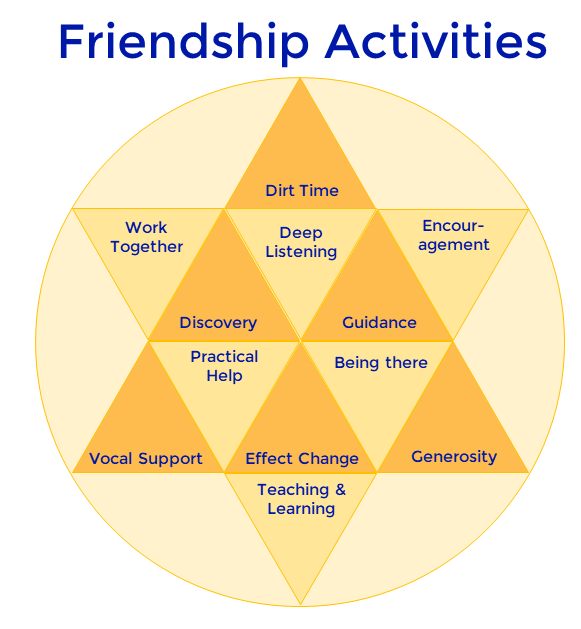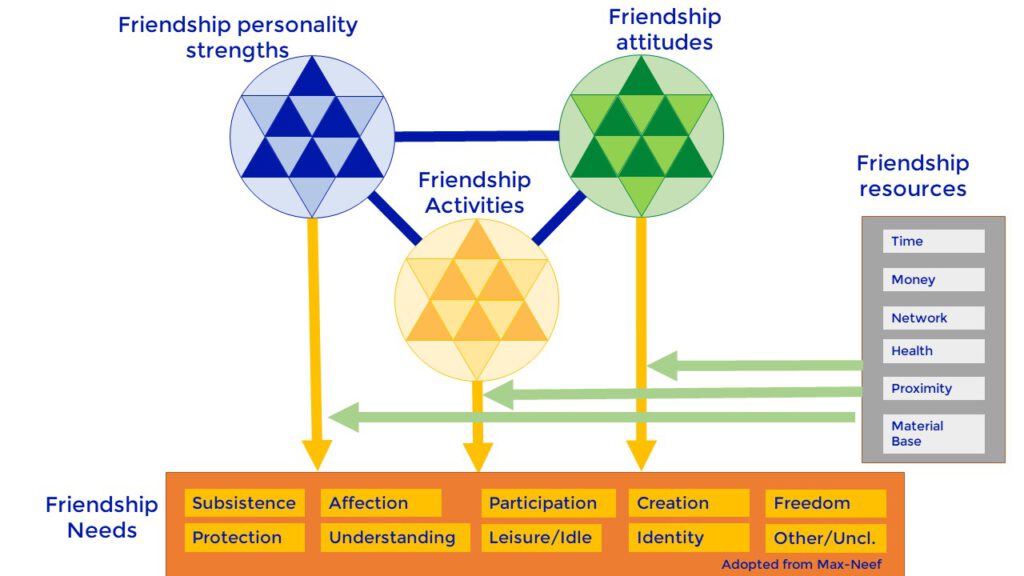The third category of the Friendship Inventory are the Activities, which you do with your friends. In a single encounter, several of these activities can be pursued, but they are more a classification of activities specifically designed to maintain and deepen a friendship.

Dirt Time and Hanging Out
This is the pure spending time in each others company. It doesn’t so much matter what you do, or how you do it, but that you spend the time together and thus build up a greater familiarity. Eating together, hanging out, drinking, taking walks, anything really as long as you are in each others company.
Working together or pursuing an interest/ hobby / sport together
Here the unifying element is the common goal or task. This builds acquaintance as you learn to appreciate the others approaches, energy, thinking. There is also a companionship element and bonding, as you work towards the goal. Some writers on friendship define this as the core element of ‘male friendship’
Allowing Expression of Self, Deep Listening and Sharing
This is the activity of one side opening up and the other one being deeply attentive in order to enable it. Depending on the needs of the situation this can be one-sided (in a crisis) or interactive (general sharing encounter), and over time builds a deep understanding towards each other. Some writers on friendship define this as the core element of ‘female friendship’.
Encouragement and Challenge
This is about our friends seeing the best in us but holding us accountable to achieve it. This is both stick and carrot, cajoling our friends to push towards their goals, and challenge them whether they are doing enough, as well as helping them to keep up the spirit in difficult situations
Expansion and Discovery
This is the joined activity of exploring – both physically out into the world, museums and new places, as well as mentally to new topics, theories and experiences, satisfying our mutual curiosity.
Guidance and Giving Direction
Helping a friend make sense of a situation, talking through the pros and cons, asking questions that helps him/her structure and get perspective as well as using our own experience and insight to support the decision process is helpful and meaningful for our friends wellbeing.
Practical Help and Doing Favours
This activity is the classical baby sitting or helping out with homework. Meeting our friends practical need by our investment of time and effort to their benefit. Knowing you repeatedly are there to support and get your hands dirty is a powerful display of valuation and appreciation.
Being there and general support
This activity is being there when your friend needs you, be it at the funeral of another person, for venting after a romantic breakup or coming to the hospital. No advice, no practical help, no deep listening, just being there and showing you have your friends back.
Vocal Support and Advocacy
Having your friends back vocally, affirming that you have his back even when they are being criticised by others or when the going gets tough, introducing them to other people in your network and commenting positively in their presence and absence.
Effect Change
This (rare) activity is a particularly powerful one. If the continual interaction with you your friend changes for the better, it is a powerful connector. The mechanisms can be diverse, whether by inspiration of presence, direct encouragement or challenge, guidance, honest harsh feedback or slow and patient prodding, but attributing a positive personal change to the action of a friend will empower the friendship for a long time.
Generosity and making gifts
Whilst in our over affluent society gifts are a little out of fashion, well placed and thoughtful gifts have historically been a key ritual and habit between people to build connection. Not by accident is this one of Chapman’s key love languages and arguably a bit of a lost art.
Teaching and Learning
Both teaching and learning from each other is a deeply memory building experience as you invest in each others growth. It often occurs in tandem in working on a joined goal or passion, but also conveys caring.
Embedding and Circle Bonding
This is about embedding the pairwise friendship in a group, of three, four or five people, each of whom complementing each other, enhancing each others jokes, insights, listening and understanding capabilities and advice giving. So even if one person becomes quiet or stressed, the friendship is maintained in the embedding in the circle of friends.
This constitutes the yellow circle in the Friendship Framework

